- 时间点:
- 时 分 秒 当前视频时间点
- 问题:
-
- 选项一
设为正确答案
新增选项 - 选项一
- 正确跳转时间:
- 时 分 秒 同锚点时间
- 错误跳转时间:
- 时 分 秒 同锚点时间


恭喜你,回答正确~
很遗憾,回答错误~
正确答案: ,您可以



本课的牛津高中英语模块十一为高中阶段选修教材。该教材Grammar and usage板块通过语法规则的讲解与多种图示的呈现,让学生比较全面系统地掌握语法知识。讲解通俗明了,浅显易懂。学生可以根据语法规则,完成书中的练习。语法配有精炼恰当的文字说明和一目了然的图片,表格,所选例句语言地道。语法训练所选用的语言材料和所设计的练习与单元话题相联系。高中英语新课程标准强调培养学生英语核心素养-语言能力,文化意识,思维品质和学习能力。本单元语法学习内容是英语语言学习中最常见的修辞手法-明喻和暗喻。对于这一修辞手法的学习。教材给了大量生动有趣,浅显易懂的例句。练习形式多样,配合诗歌赏析。里面有很多英语常用的有关明喻和暗喻的习语。学生在学习过程中能够了解英语文化,体会英语与中文的不同思维,加强文化意识。在该模块的学习中,学生可以进一步满足学习英语的需要,加深对英语语言的理解,提高他们在现实生活的各个领域中运用英语语言的能力和对英美文学,影视的鉴赏能力,并进一步促进掌握听,说,读,写的技能。在这个过程中,学生掌握有效的学习策略,有助于提高学习效率,促进自主学习能力的发展。
教学对象为高三年级学生,英语基本语法掌握情况良好。积累了一定的语言知识和英语词汇,能用英语进行日常交际。但是对英语语言的文化,英语文学赏析的素养还有所欠缺。高三学生在各种高考题型特别是阅读理解中都遇到过明喻或者是暗喻的句子。在平时授课中,教师也会对常见比喻进行解释,学生对于明喻和暗喻并不陌生。如果学生能够在新高考英语新题型-读后续写中,巧妙地运用明喻和暗喻来进行描写,必然会使他们写出的文章更加生动活泼,栩栩如生。因此,学生对于英语修辞手法的学习兴趣相当浓厚。有进一步学习,全方位提高自己英语能力的愿望。考虑到学生的水平参差不齐,因此在教学过程中,教师布置的任务要兼顾各个不同层次的学生,使他们都有所获。
To help students recognize and know about two common types of figurative language-Simile and Metaphor.
To guide students to appreciate similes and metaphors in lyrics and literature works.
To guide students to apply similes and metaphors to writing.
To encourage students to appreciate beauty in life and to develop a positive attitude towards life.
How to get the students to understand the two types of figurative language- simile and metaphor.
How to tell the difference between simile and metaphor.
How to help students apply what they have learnt to writing.
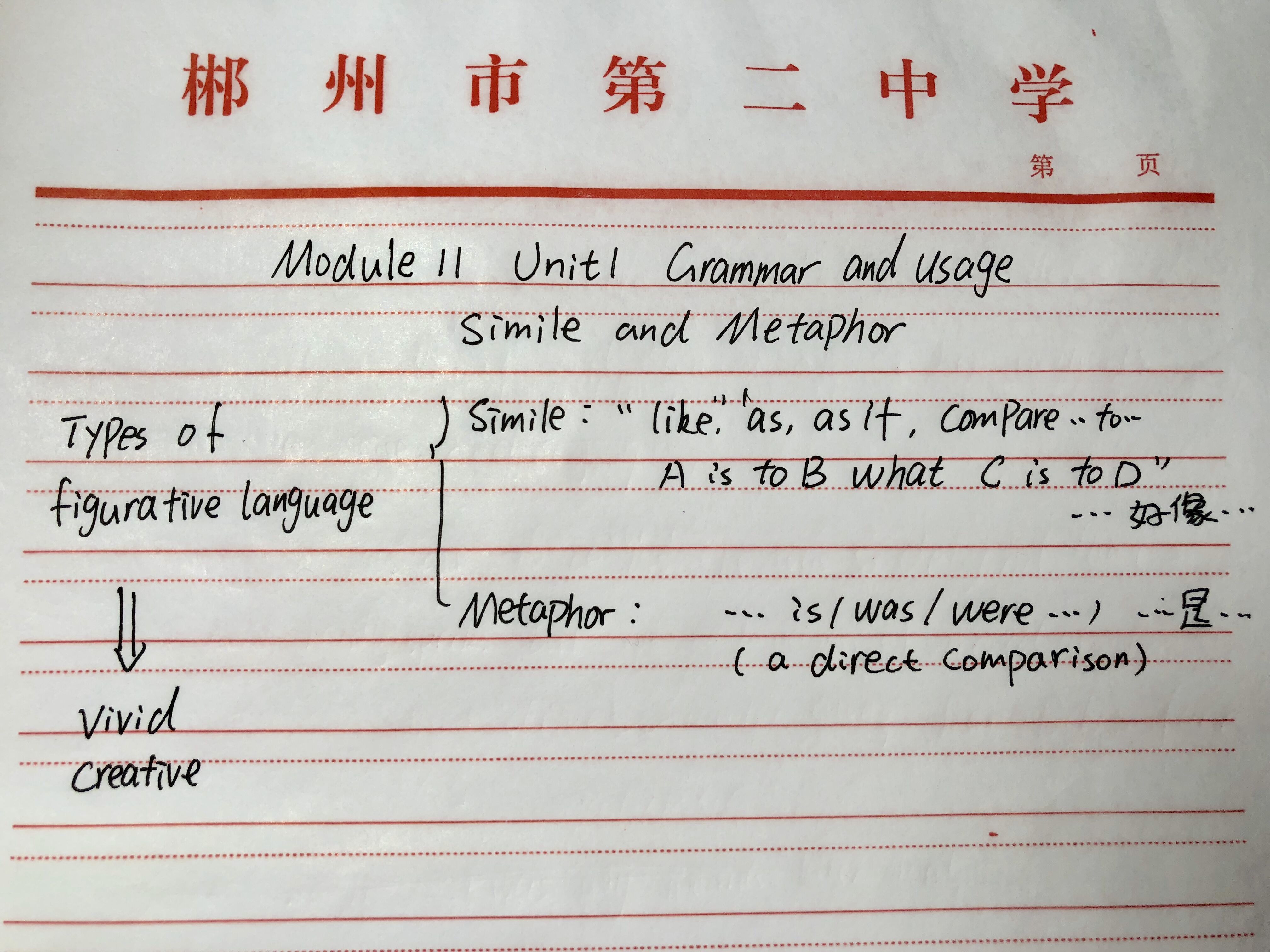
Boys and girls, Have you heard of this song "Twinkle Twinkle little Stars"? Let's sing along with the music.
Show the lyrics of the song.
underline the sentence: "...like a diamond in the sky"
What does it mean in Chinese? What figurative language is used ?
Ask students to open their textbooks and turn to page 8.
Simile:
Show the sentence" A little star looks like a diamond."
1.What is a simile?
Definition: A simile is a comparison of two different things which share some similarities, with simile markers "like" or "as".
2.Learn more about simile:
Enjoy a micro-lecture about simile.
More examples of similes in the video:
1.The smile on her face shines like a diamond.
2. Bob runs as quickly as a deer.
3. Butterflies flew around us as if we were in a magical world.
4.The poet compares his lover’s tongue to a knife.
5.A friend is to me what water is to a fish.
3.Find out the similes:
A. Tom likes teaching.
B. As a teacher, Tom is as busy as a bee.
C. The girl swims like a fish.
D. Let life be beautiful like summer flowers and death like autumn leaves.(By Tagore)
Metaphor:
1. Let's enjoy a song-The Rose
While Listening, please fill in the blanks in the lyrics.
" Some say love (it) is a __________,
that drowns the tender reed.
Some say love(it) is a razor
that leaves your soul to bleed.
Some say love (it) is a _________,
and endless aching need.
I say love (it) is a ____________,
and you its only seed.
2. Show the sentence: "I say love is a flower." Then, ask students What figurative language is used ?
3. What is a metaphor?
Definition: A metaphor states that one thing is someting else. It does not use "as" or "like" to make any comparison.
4. Learn more about metaphor:
Enjoy another video about metaphor.
1.The old man’s face is a map of time.
2.Her hair was a flowing golden river streaming down her shoulders.
3.He doesn’t have an idea of his own. He just parrots what other people say.
4.The years have silvered her hair.
5.Hearing the news, so desperate was he that he drowned sadness in wine.
5. Find out the metaphors:
A: The boy wolfed down the food the moment he got it.
B: Idioms are carriers of history and culture.(M9U4 Reading)
C: Louis Cha is a walking encyclopedia(百科全书) of Chinese. He knows so much about Chinese.
D: Richard enjoyed that book while I hated it. One man's meat is another man's poison.
What is the main difference between similes and metaphors?
Similes use the words “like,as, as if, compare to”to make comparisons.
In contrast, metaphors directly state a comparison.
Pair Work:
Ask students todiscuss and work with their partners and finish Part A and Part B on page 9 in their textbooks.
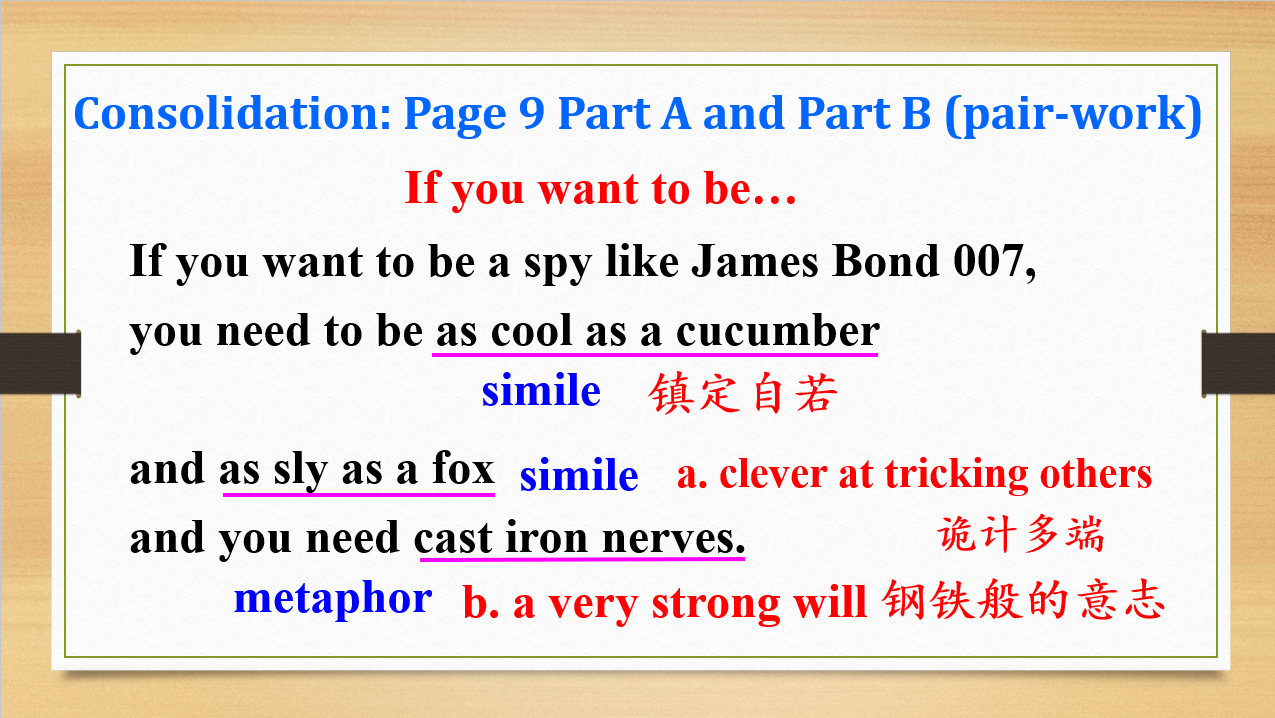

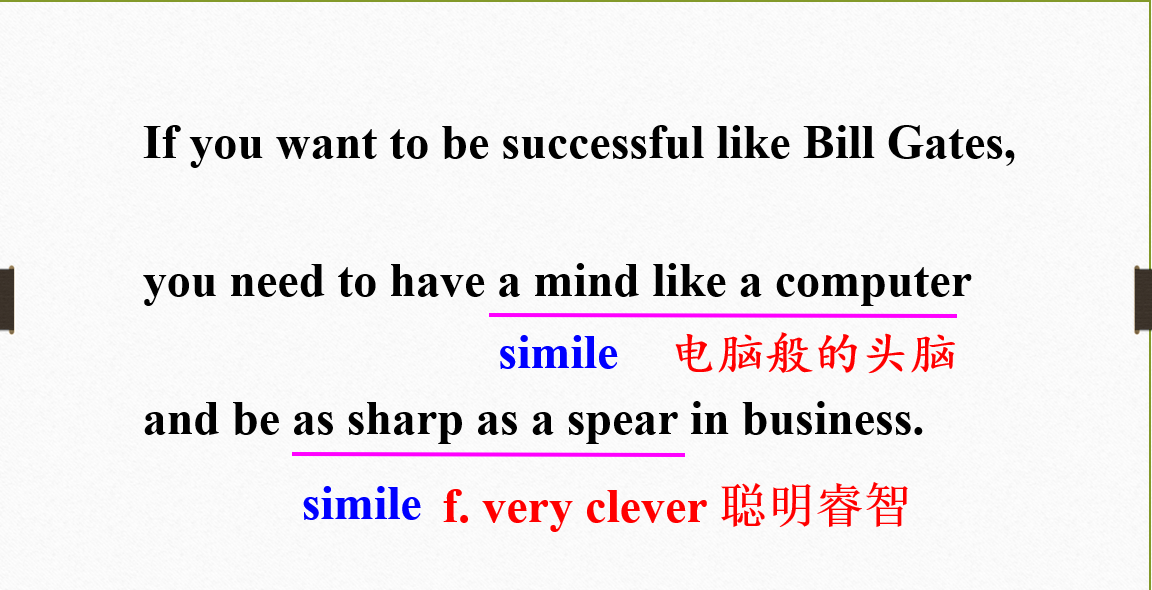


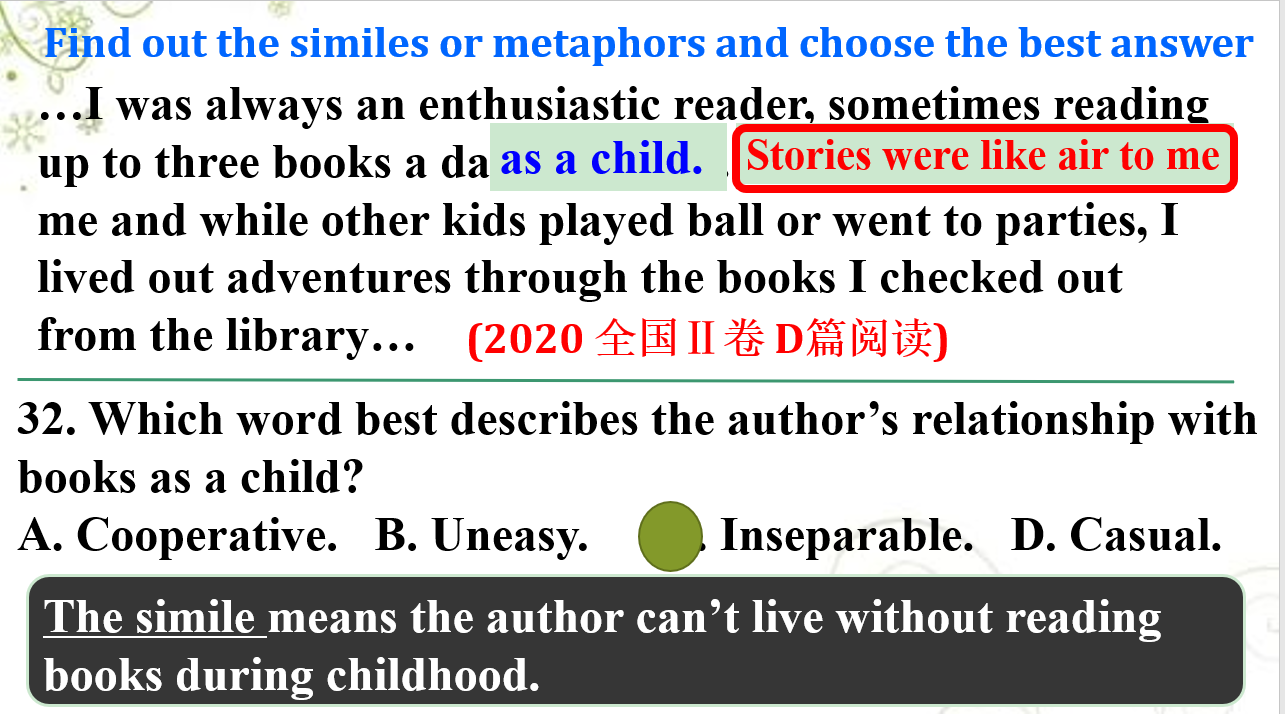

The summary:
In reading, _____________(similes and metaphors) are very common.
What should we do?
. Enlarge our vocabulary.
. Try to figure out the implied meanings behind the similes and metaphors.
2. Application in "continuation writing"(读后续写)

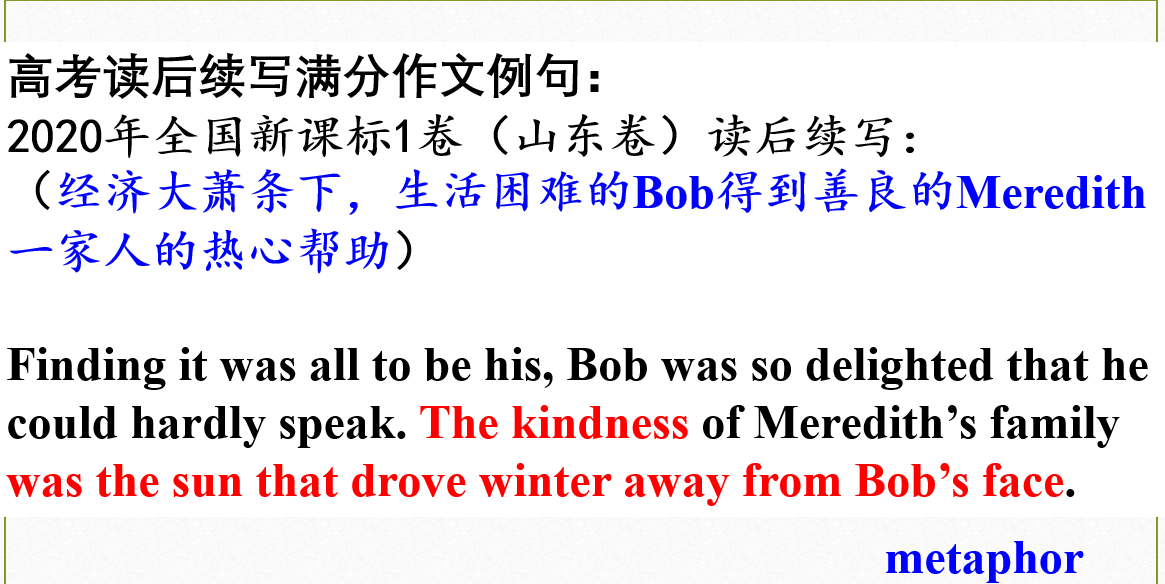
The Summary:
When it comes to writing, we could use similes and metaphors to make our writing more vivid and creative.
Group Work-Work together with your group members.
Divide the class into 2 groups
Work and discuss with your group members to write sentences using similes or metaphors. The more the better!
Note:
1. Group 1--Similes
2. Group 2--Metaphors
1. Find more famous quotations using similes or metaphors.
2. Finish C1 and C2 on page 96 in Workbook.
设为正确答案